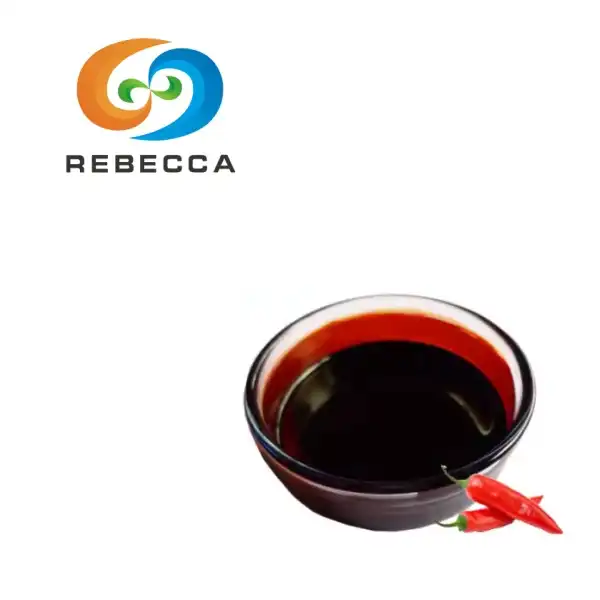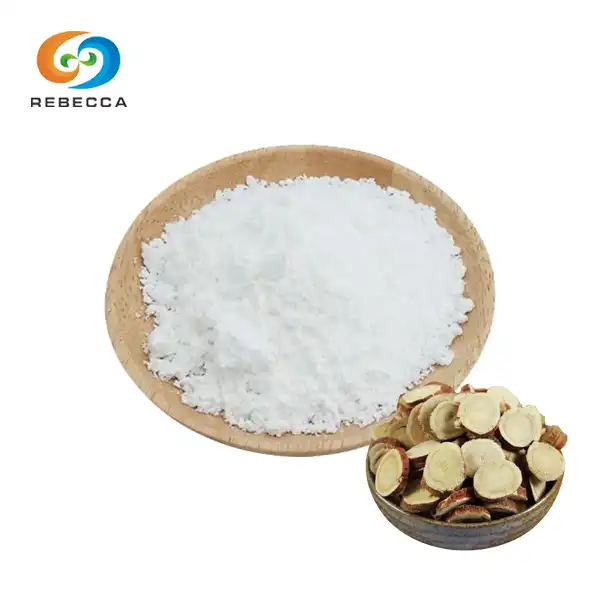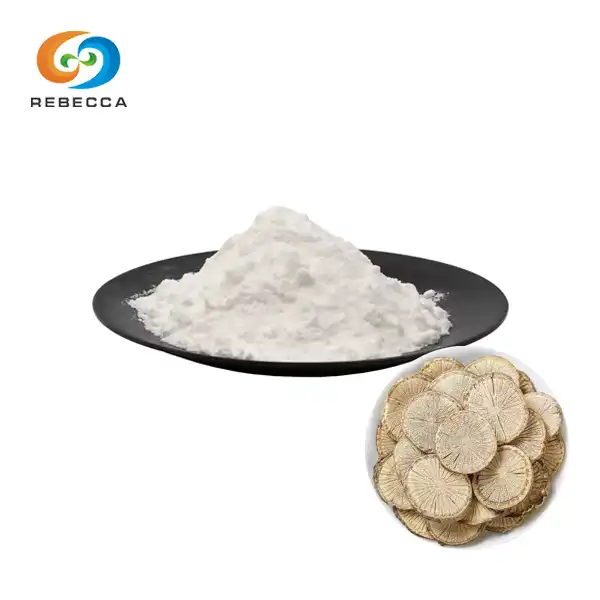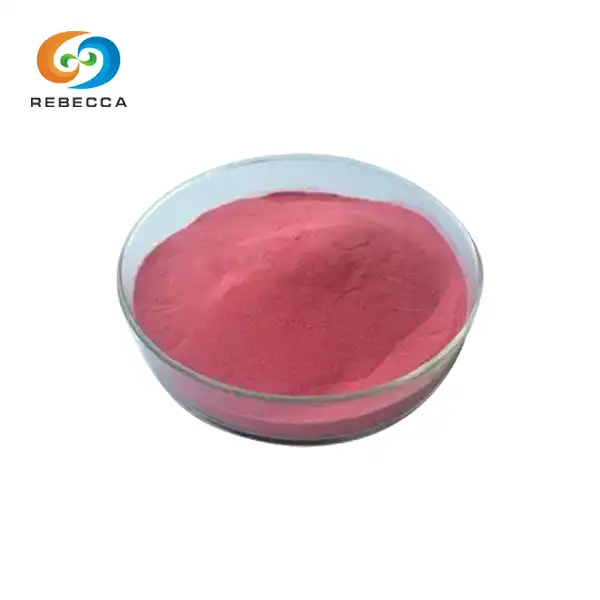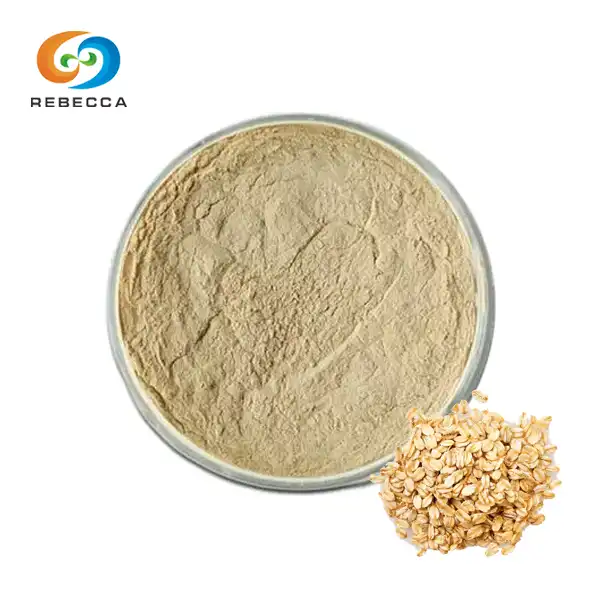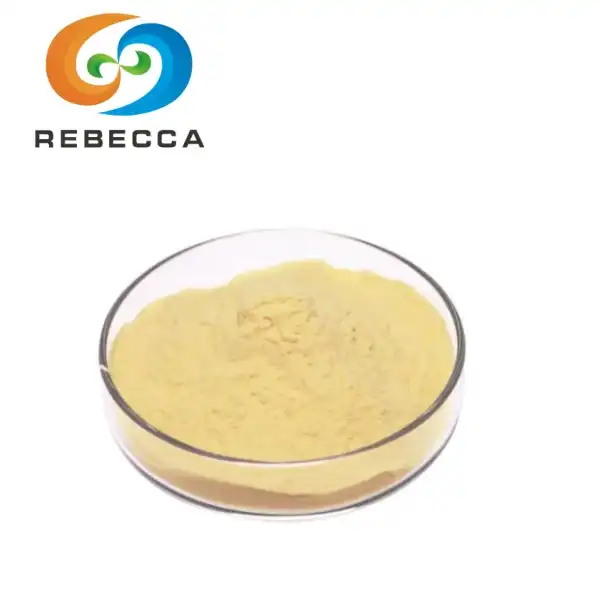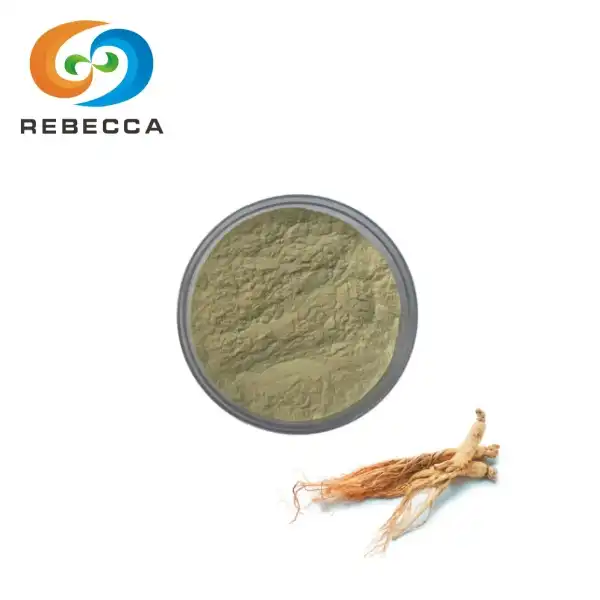What is the difference between ashwagandha and ashwagandha root extract?
Ashwagandha and ashwagandha root extract differ primarily in their potency and bioavailability. Ashwagandha refers to the whole root of the Withania somnifera plant, while ashwagandha root extract powder is a concentrated form derived from the root. The extract contains higher concentrations of active compounds, particularly withanolides, which are responsible for many of the herb's health benefits. This concentration process typically results in a more potent product, allowing for smaller doses to achieve similar effects. Understanding these differences is crucial for pharmaceutical R&D companies, health supplement brands, and other industries seeking to harness the full potential of this adaptogenic herb.
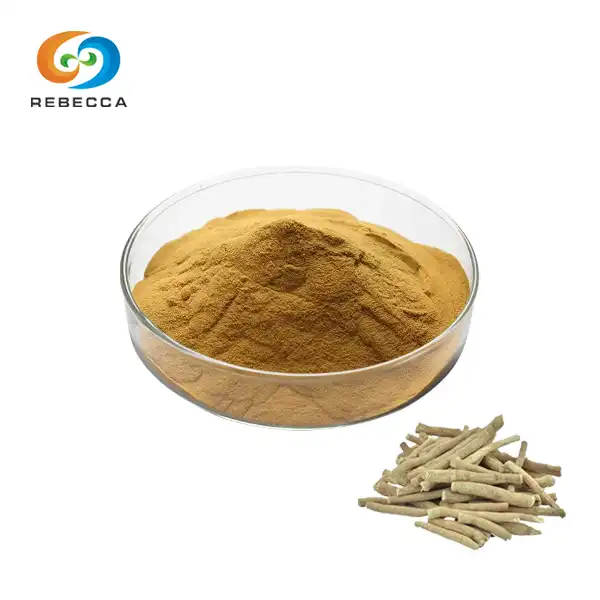
【English name】: Ashwagandha Root Extract Powder
【Latin Name】: Withania Somnifera
【CAS No.】: 30655-48-2
【Molecular Formula】: C28H38O6
【active ingredients】: Withanolide
【Specification】:1.5% 5% 20%
【Use Part】 :Root
【Appearance】: Brown to Brownish-yellow Fine Powder
【Mesh size】:80 Mesh
【Test Method】: HPLC
Whole Root vs Extract: Which Form is More Potent?
Comparing active compounds in whole root and extract
The potency of ashwagandha products largely depends on their active compound profile. Whole ashwagandha root contains a complex array of bioactive substances, including alkaloids, steroidal lactones, and saponins. However, these compounds are present in their natural, less concentrated form. In contrast, ashwagandha root extract powder undergoes a sophisticated extraction process that concentrates these beneficial compounds, particularly the withanolides.
For pharmaceutical R&D managers and health supplement formulators, understanding this concentration process is vital. The extract typically offers a more consistent and potent source of active ingredients, which can be crucial for developing standardized products. This consistency is particularly important for batch-to-batch uniformity in production, a key consideration for companies adhering to strict quality control measures.

Potency analysis: Withanolides in root vs extract
Withanolides, the primary bioactive compounds in ashwagandha, are present in significantly higher concentrations in the extract compared to the whole root. While the whole root typically contains 0.1-0.5% withanolides, high-quality Ashwagandha root extract powder can contain up to 5% or more. This increased concentration translates to enhanced potency, allowing for smaller, more effective doses in supplement formulations.
For product developers in the health supplement industry, this potency difference is a crucial factor in formulation decisions. Higher withanolide content in extracts can lead to more efficacious products, potentially offering stronger stress-relief and adaptogenic benefits. However, it's important to note that the full spectrum of compounds in whole root may offer synergistic effects that are not fully replicated in some extracts.
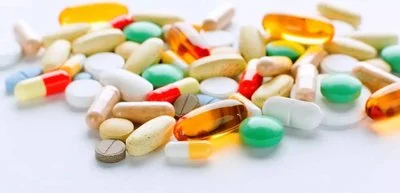
Clinical studies on efficacy of root powder vs extract
Numerous clinical studies have compared the efficacy of ashwagandha root powder to its extract form. Generally, these studies indicate that while both forms offer health benefits, the extract tends to show more pronounced effects at lower doses. For instance, a study published in the Journal of Ayurveda and Integrative Medicine found that KSM-66, a patented ashwagandha extract, demonstrated significant improvements in stress reduction and sleep quality at doses as low as 300mg per day.
These findings are particularly relevant for R&D managers in pharmaceutical companies and formulators in the health supplement industry. The higher efficacy of extracts at lower doses can lead to more cost-effective and consumer-friendly products. However, it's crucial to consider that some studies also suggest unique benefits of whole root powder, emphasizing the importance of choosing the right form based on specific product goals and target outcomes.
Bioavailability Battle: Root Powder or Concentrated Extract?
Absorption rates: Ashwagandha root vs extract powder
The bioavailability of ashwagandha compounds is a critical factor in determining its effectiveness. Ashwagandha root extract powder typically demonstrates superior absorption rates compared to whole root powder. This enhanced bioavailability is due to the concentrated nature of the extract and the removal of certain plant materials that might hinder absorption.
For functional beverage manufacturers and health supplement brands, this improved absorption rate is a significant advantage. It allows for the development of products that can deliver effective doses of active compounds more efficiently. However, it's important to note that the absorption rates can vary depending on the specific extraction method and the presence of other ingredients in the formulation.
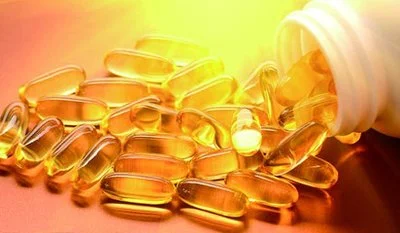
Digestive impact: Whole root fiber vs extracted compounds
Whole ashwagandha root powder contains natural fibers and other plant materials that are largely absent in the extract form. These fibers can have both positive and negative impacts on digestion and overall bioavailability. On one hand, the fiber content in whole root powder may support digestive health and promote a slower, more sustained release of active compounds. On the other hand, these same fibers can potentially interfere with the absorption of some bioactive components.
Extract powders, being more concentrated and free from most plant fibers, typically cause less digestive strain and may be more suitable for individuals with sensitive stomachs. This aspect is particularly relevant for product developers in the health supplement and functional food industries, where digestive comfort and nutrient absorption are key considerations in formulation.
Bioenhancement techniques for improved ashwagandha uptake
To maximize the bioavailability of ashwagandha, various bioenhancement techniques have been developed. These methods are particularly relevant for Ashwagandha root extract powder, where optimizing absorption can lead to more effective products. One common technique is the use of piperine, a black pepper extract known to enhance the absorption of various herbal compounds.
For R&D managers and formulators, exploring these bioenhancement techniques can lead to more potent and effective products. Some manufacturers are also experimenting with advanced delivery systems, such as liposomal encapsulation, to further improve the bioavailability of ashwagandha extracts. These innovations are particularly exciting for the pharmaceutical and nutraceutical industries, potentially leading to more efficient and effective ashwagandha-based products.

Choosing Your Ideal Ashwagandha: 2 Key Factors
Standardization: Ensuring consistent potency in extracts
Standardization is a crucial factor in choosing the ideal ashwagandha product, especially for pharmaceutical and supplement manufacturers. Standardized Ashwagandha root extract powder ensures a consistent level of active compounds, particularly withanolides, in each batch. This consistency is essential for maintaining product efficacy and reliability.
For R&D managers and quality control teams, working with standardized extracts simplifies the formulation process and ensures batch-to-batch consistency. It also allows for more accurate dosing and predictable results in clinical studies. When selecting an ashwagandha extract, look for suppliers who provide detailed standardization data and employ rigorous quality control measures.
Dosage recommendations: Root powder vs extract forms
Dosage considerations vary significantly between ashwagandha root powder and extract forms. Typically, ashwagandha root powder is used in higher doses, ranging from 1-6 grams per day, while extracts are effective at much lower doses, often between 300-600 mg daily. These differences are crucial for formulators and product managers in the supplement industry.
When determining the ideal dosage for a product, consider factors such as the intended use, target audience, and desired effects. Extracts, with their higher potency, allow for smaller, more convenient doses, which can be advantageous for compliance and product formulation. However, whole root powder might be preferred in certain traditional or holistic formulations. Always refer to clinical studies and regulatory guidelines when establishing dosage recommendations for your specific product.
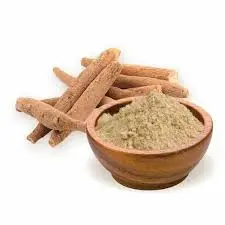
Conclusion
In conclusion, the choice between ashwagandha root and its extract form depends on specific needs and applications. Ashwagandha root extract powder offers higher potency, improved bioavailability, and standardized content, making it ideal for pharmaceutical and nutraceutical applications requiring precise dosing and consistent effects. Whole root powder, while less concentrated, provides a full spectrum of natural compounds that may offer unique benefits. For industry professionals, understanding these differences is crucial in developing effective, high-quality products that meet consumer needs and regulatory standards.
Where to Buy Ashwagandha Root Extract Powder?
For high-quality ashwagandha root powder, look no further than Shaanxi Rebeccia. Our production base is equipped with internationally leading extraction, separation, and purification equipment, and operates in strict compliance with GMP and ISO standards. From raw material procurement to finished product delivery, every step undergoes rigorous quality control to ensure the safety and efficacy of our products. We offer standardized ashwagandha extract powder with consistent withanolide content, suitable for various applications in the pharmaceutical, nutraceutical, and cosmetic industries. For inquiries about our Ashwagandha root extract powder or other herbal extracts, contact us at information@sxrebecca.com.
References
- Singh, N., et al. (2011). An overview on ashwagandha: A Rasayana (Rejuvenator) of Ayurveda. African Journal of Traditional, Complementary and Alternative Medicines, 8(5S).
- Chandrasekhar, K., et al. (2012). A prospective, randomized double-blind, placebo-controlled study of safety and efficacy of a high-concentration full-spectrum extract of Ashwagandha root in reducing stress and anxiety in adults. Indian Journal of Psychological Medicine, 34(3).
- Lopresti, A. L., et al. (2019). An investigation into the stress-relieving and pharmacological actions of an ashwagandha (Withania somnifera) extract: A randomized, double-blind, placebo-controlled study. Medicine, 98(37).
- Durg, S., et al. (2015). Withania somnifera (Ashwagandha) in neurobehavioural disorders induced by brain oxidative stress in rodents: A systematic review and meta-analysis. Journal of Pharmacy and Pharmacology, 67(7).
- Trivedi, M. K., et al. (2017). Biofield energy healing treatment for yielding a potent ashwagandha root extract: Impact on physicochemical and thermal properties using modern analytical techniques. Pharmacognosy Research, 9(Suppl 1).
